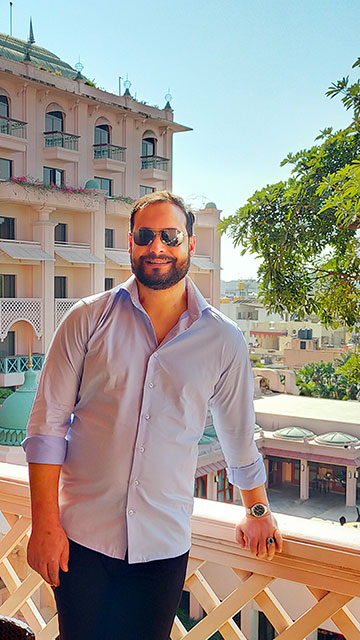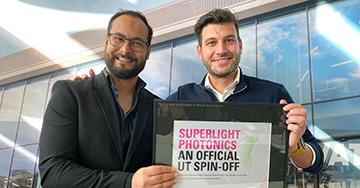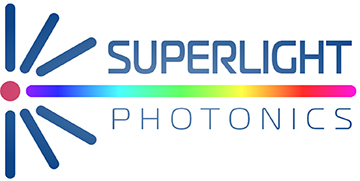
Haider Zia. [Image: Courtesy of H. Zia]
The July/August 2023 issue of Optics & Photonics News featured the magazine’s biennial feature spotlighting 10 Entrepreneurs to Watch. Here, we offer an interview with one of those entrepreneurs, Haider Zia, the founder and managing director of Netherlands-based Superlight Photonics. Superlight—which is currently exploring various markets—capitalizes on Zia’s postdoctoral research on so-called sign-alternating-dispersion waveguides to produce low-power supercontinuum lasers.
Could you give us the elevator pitch for Superlight Photonics?
Haider Zia: We specialize in large-bandwidth, integrated laser sources. We use the technology that I developed in during my postdoc that generates what’s called a supercontinuum spectrum, which is a highly efficient, wide bandwidth of light.
And this really has large ramifications for industry. For example, this large-bandwidth light is laser light, so it’s totally coherent. It’s also done in an integrated setting. And it can now use very, very small seed lasers, which was not possible before. So we could shrink down from a full tabletop to portable, handheld devices.
So with that main technology, we’d like to explore verticals in the industry. We’d like to offer our technology to interested parties, for example, in the research-and-development sphere.
Why is the combination of supercontinuum on chip so important right now?
Essentially, the supercontinuum laser acts as a source. There’s lots of applications that require highly coherent laser light, but with multiple colors. So our product could be viewed as replacing an array of different lasers. One laser can output all the colors with better noise performance characteristics than the array lasers. For example, in imaging technologies such as optical coherence tomography (OCT), people would like to scan with a large bandwidth. However, constraints currently exist.

While supercontinuum lasers have a potential to be really great technology for the industry, it hasn’t really taken off because they are expensive and bulky. It’s also constrained to optical laboratory environments. For example, the OCT devices—the same devices that image the eye in doctor’s offices—have a scanning laser across the color spectrum. But it’s very slow to just tune one laser to hit all of those colors. And it’s expensive.
So we hope that we can help make better OCT devices. Our technology could also be used in spectroscopy, for example, where you need to detect the chemical signature of a compound across a large bandwidth of optical radiation. It could be used in imaging also, since the large bandwidth basically means large amounts of information.
The technology can also cut the power requirements for these devices, if I’m understanding it correctly. How does that technology work?
Part of the reason why supercontinuum generation is not readily available for industry is that it requires large-power pump sources, which increases the cost, the space, everything. And those pump sources are required because the large bandwidth of light is generated in the material as it interacts with a strong optical field.
So essentially, the pump laser loosens electrons in the material, and these electrons start radiating at different frequencies from the pump frequency. And that’s what creates this broadband spectrum. But at the same time, [in a normal-dispersion material] all of these extra frequencies that are generated by the electrons disperse out from the main pulse. So the pulse basically stretches in time, and it loses its peak power. And if it loses its peak power, the process stops, as it’s dependent on this peak power.
“Part of the reason why supercontinuum generation is not readily available for industry is that it requires large-power pump sources, which increases the cost, the space, everything.” —Haider Zia
Another case uses anomalous-dispersion materials. In this case, the generated frequencies come together and the peak power goes up, contrary to human intuition, which is a good thing. But then the pulse shapes into something called a soliton, a mathematically stable solution that cannot generate any more frequencies.
So in both cases—the normal dispersion, where the pulse falls apart, and the anomalous dispersion, where the pulse shapes itself into a stationary soliton—after a certain propagation distance, you won’t generate any bandwidth. So to generate more bandwidth, you have to increase the power. But due to these processes, the bandwidth scales proportionally to the square root of the power. So it’s not really a viable solution.
So what we do at Superlight Photonics is that we alternate the dispersion across the waveguides in segments. First, there’s a section that’s normal dispersion, then a section that’s anomalous dispersion, and so forth. And essentially, when the pulse falls apart, it regroups itself in anomalous dispersion, shaping into the stationary solution, it then goes back into a normal-dispersion segment. And with that, we can keep the generation process happening for a longer propagation length. And therefore, with a given power, we can generate more spectrum. And that means that we can lower the power requirements.
And by quite a bit.
Yes. Our power requirements are lowered by up to thousands of times compared with the power requirements of supercontinuum schemes that were published in the last five years.
“Our power requirements are lowered by up to thousands of times compared with the power requirements of supercontinuum schemes that were published in the last five years.” —Haider Zia
Let’s turn the focus a bit more toward you and your background. Could you tell me when you first became interested in science and technology and in optics and photonics?
When I was a kid in the 1990s, there were a lot of mainstream scientific publications, like Scientific American. And my father was really interested in all of that. He’s a banker and a businessman, but he’s also really interested in science. So we would read that together. And that built up my interest in science. I actually wanted to be an astrophysicist growing up.
But I also thought that light was really mysterious. So in my teens, I started to really get interested in light, asking questions like, What is light? Why is it that we can see? What are colors? In university, I did a degree in engineering physics. And there was a course in laser physics. And when I took that course, it was just like magnetic interest. And it continued from there.
Have you also always had an interest in starting a business?
I was always impressed with tech companies that do really groundbreaking research and offer something meaningful to the society. I found that just focusing on the research and the academic route, you miss a lot of things. You miss out on making connections with different fields, even away from science, for example, with business. You’re like a horse wearing a blinder on a race track; you’re limited to a certain field.
“I found that just focusing on the research and the academic route, you miss a lot of things. You miss out on making connections with different fields, even away from science, for example, with business.” —Haider Zia
But there’s so much funding in academic research, and in every introduction of papers, they talk about the applications—how companies and industry could benefit. But then the academics often don’t do anything with that. And then the society has to wait a long time until that research goes into industry. Then patents can’t happen, so companies lose interest.
So I wanted to start a company that could take high-end, deep-tech, scientific research and generate revenue. A product that could keep the enterprise going without the need for external funding from government sources and could help society.
You mentioned that the technology was coming out of your postdoc work at the University of Twente. Could you talk a little bit about how and when you came to understand this was something that might have good commercial prospects?
After my Ph.D. in fiber lasers, I asked myself, “What’s the next coolest thing?” Well, the next coolest thing, I thought, was photonic chips, light-based chips. So I was looking around—I did my Ph.D. in Hamburg [Germany], so I was looking for places close by that would have a very high impact in that field, and found the University of Twente. It has one of the key foundries for building these optical chips, essentially on campus. So the school is really involved in the field. And it had an opening, so I applied.
My research tenure at Twente was to look at nonlinear processes and supercontinuum generation in these photonic chips. And during that research tenure, one day, I was traveling back to Hamburg on a train, and I was super-bored. So I started to think about research. And then this idea of alternating dispersion came to mind.

Haider Zia (left) with Jaap Beernink, CEO of Novel-T. [Image: Courtesy of H. Zia]
What was the process of founding the company like?
It happened in November of 2022, so we are brand new. But all the research was done over the course of many years. Our patents are from 2020.
Another good part about the University of Twente is that it’s an entrepreneurial university. So there’s an entrepreneurship side to it, a very well-developed business development aspect within the university called Novel-T. It offers business coaching, basically guiding you through the whole process of taking your academic research and founding a company. It has connections to the major venture capital firms in the Netherlands that are interested in investing in deep tech technologies. It was really with Novel-T’s help at first that the business came to fruition.
Where does your company stand in terms of funding?
Another great thing about being in the Netherlands is that there are a lot of investments in the photonics industry. So there are initiatives like PhotonDelta. That also means that there are a lot of VC [venture capital] firms that are also interested in photonics. So we are in that process of getting capital into the company through VC firms.
There are a lot of opportunities in Europe as a whole for companies as well. For example, there’s the European Innovation Council’s EIC Accelerator, which offers up to €2.5 million in nondiluted funding. So yeah, there are a lot of opportunities if you have a good idea.

Right now, Superlight Photonics is hiring. We’re going to put out job advertisements soon. We’re also almost done closing our seed financing round. And we’re working with our financiers to build the company right now. We’re a very young company.
What are some of the markets you’re considering for the technology? Are there specific segments you will be targeting first?
Those are the ongoing discussions. Currently, we’re studying the markets, the market sizes, the top players in each market where we could compete, and potential partnerships. Those things take time. We’re also looking at becoming a component provider as well and the economics of that. That’s pretty much the stage we’re at now.
You already have a great piece of advanced photonics research and demonstrated that this approach works. What are the main challenges in your R&D in scaling it?
Right now, we have a product available. It’s packaged on chip with a fiber feedthrough. And in terms of the foundries, what you do is basically you submit your designs, and then they just generically print them on chip. So a part of the appeal of integrated photonics is that scaling is easier to do than in fiber because we use the CMOS technology that’s been developed for the electronics industry.
“A part of the appeal of integrated photonics is that scaling is easier to do than in fiber because we use the CMOS technology that’s been developed for the electronics industry.” —Haider Zia
The industry is still new to the integrated-optics sphere. For example, the seed [laser] source and all that has to be scaled as well. So it’s not only the chip; the things that go around the chip also have to be scaled. And because the industry is not used to large amounts of purchase orders—it really serves the research-and-development sector at the moment—we’re trying to see where we can scale up rapidly.
What are some of the lessons you’ve learned so far? What advice would you give to someone who’s interested in starting a business?
I would say the most important thing is that, if you’re passionate about the subject and if you believe you have a good idea, you should pursue it without being discouraged. So for example, when I first started out with the supercontinuum stuff, people told me that this has been researched for the last 10, 15 years. It’s a dead field. There are so many publications, where are you going to do to make your contribution to supercontinuum generation? I would get comments like that.
My advice is that you should rely on pure intuition, instinct and passion, rather than focusing on the end result. So rather than saying, “I want to make money,” instead, you should ask yourself, “what’s my passion?” “Where do I want to go?” Like, figure out what really interests you and just go with it.
“If you’re passionate about the subject and if you believe you have a good idea, you should pursue it without being discouraged.” —Haider Zia
My other comment is that, right now, there are a lot of distractions along the path toward the end. For example, people have multiple projects in parallel. My takeaway is to focus on one thing and pursue it till the end—which, in this case, would be having a lucrative product on the market. It is going to take a while. But it’s definitely worth it. Because at the end of the day, you’re doing what you like to do. You have a clear path when you know what to work on. You will know the next step.
What has been the most memorable moments thus far?
There are many, many things that I find extremely memorable. But I would say the first time I put the chips into the optical setup would be the most memorable. Everything was theoretical up to that point. According to simulations, there were a lot of unknowns. So when I put the chip in for the first time saw the spectrum behaving exactly like the simulations, I was like, “Wow, this is amazing.” You can do all the simulations, but at the end of the day, you just don’t know how things are going to turn out in real life. You’re as in the dark as anyone else. And really, it was matter of good fortune at that point that it worked.
Was there anything challenging or surprising translating your research into a company?
There was nothing that was hard to do in that respect. That’s really thanks to the support system that I have here. For example, other startup companies would have to hire a lot of people for the business development, but I got that basically for free. And I’m really thankful for that. I was lucky in that sense.
But of course, we’re still a young company. So I’m sure there’s going to be something in the future.
You mentioned that your dad is a businessman. Did he have any influence on you starting a business?
Definitely. He fully encouraged it. And he can talk hours about how business works. He’s been there for every step of the process. He’s my close advisor. I definitely got closer to my father along the process, which is good.
